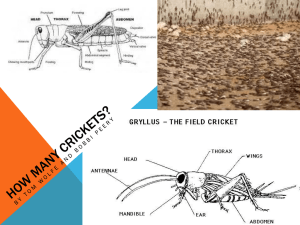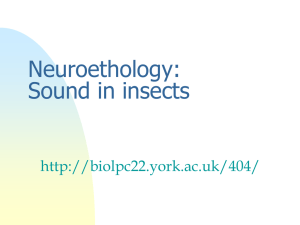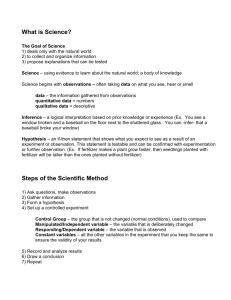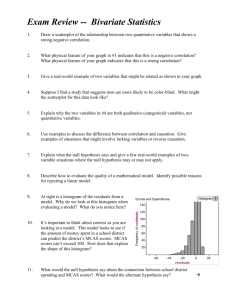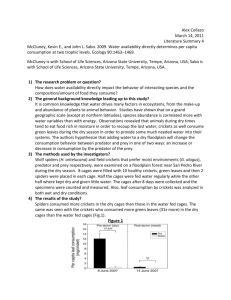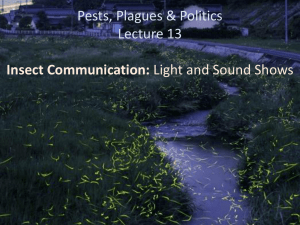Crickets As Models For Insect Immunology
advertisement
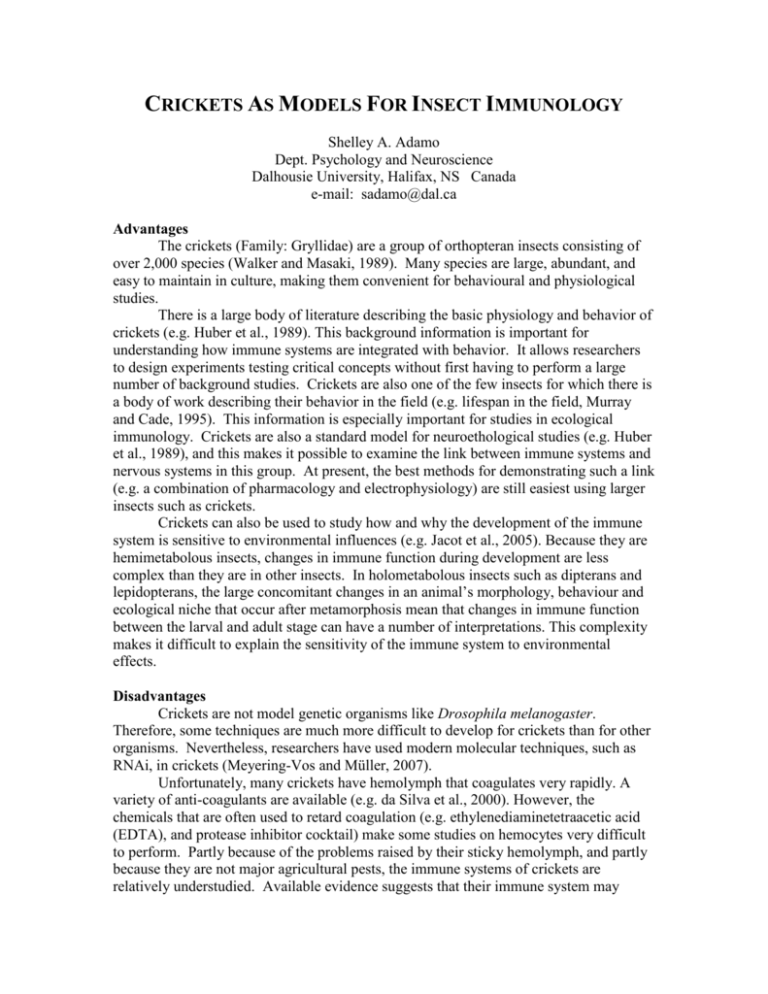
CRICKETS AS MODELS FOR INSECT IMMUNOLOGY Shelley A. Adamo Dept. Psychology and Neuroscience Dalhousie University, Halifax, NS Canada e-mail: sadamo@dal.ca Advantages The crickets (Family: Gryllidae) are a group of orthopteran insects consisting of over 2,000 species (Walker and Masaki, 1989). Many species are large, abundant, and easy to maintain in culture, making them convenient for behavioural and physiological studies. There is a large body of literature describing the basic physiology and behavior of crickets (e.g. Huber et al., 1989). This background information is important for understanding how immune systems are integrated with behavior. It allows researchers to design experiments testing critical concepts without first having to perform a large number of background studies. Crickets are also one of the few insects for which there is a body of work describing their behavior in the field (e.g. lifespan in the field, Murray and Cade, 1995). This information is especially important for studies in ecological immunology. Crickets are also a standard model for neuroethological studies (e.g. Huber et al., 1989), and this makes it possible to examine the link between immune systems and nervous systems in this group. At present, the best methods for demonstrating such a link (e.g. a combination of pharmacology and electrophysiology) are still easiest using larger insects such as crickets. Crickets can also be used to study how and why the development of the immune system is sensitive to environmental influences (e.g. Jacot et al., 2005). Because they are hemimetabolous insects, changes in immune function during development are less complex than they are in other insects. In holometabolous insects such as dipterans and lepidopterans, the large concomitant changes in an animal’s morphology, behaviour and ecological niche that occur after metamorphosis mean that changes in immune function between the larval and adult stage can have a number of interpretations. This complexity makes it difficult to explain the sensitivity of the immune system to environmental effects. Disadvantages Crickets are not model genetic organisms like Drosophila melanogaster. Therefore, some techniques are much more difficult to develop for crickets than for other organisms. Nevertheless, researchers have used modern molecular techniques, such as RNAi, in crickets (Meyering-Vos and Müller, 2007). Unfortunately, many crickets have hemolymph that coagulates very rapidly. A variety of anti-coagulants are available (e.g. da Silva et al., 2000). However, the chemicals that are often used to retard coagulation (e.g. ethylenediaminetetraacetic acid (EDTA), and protease inhibitor cocktail) make some studies on hemocytes very difficult to perform. Partly because of the problems raised by their sticky hemolymph, and partly because they are not major agricultural pests, the immune systems of crickets are relatively understudied. Available evidence suggests that their immune system may differ substantially from that of other groups, such as the dipterans and lepidopterans. For example, orthopterans do not appear to have the same antimicrobial peptides as other insects. In fact, Hoffmann et al. (1996) speculates that they may not have antimicrobial proteins at all, but may rely on lysozyme-like enzymes instead. Although it is clear crickets have more than lysozyme-like enzymes in their hemolymph (e.g. Adamo, 2004), whether they have antimicrobial peptides remains unknown. The lack of understanding about their basic immune function limits the type of immunological studies that can be done using crickets. However, information is growing about their immune function. Summary Many cricket species are large insects, with robust behavior and physiology. Entomologists have taken advantage of these traits and crickets have been well studied in some areas (e.g. Cricket Behavior and Neurobiology, eds. Huber, Moore and Loher, 1989). They are one of the few insect groups in which there has been substantial research on their behavior in the field. For these reasons, they are attractive models for studies in ecological immunology and for studying the interactions between the immune system and other physiological systems. References Adamo, S.A. (2004) Estimating disease resistance in insects: phenoloxidase and lysozyme-like activty and disease resistance in the cricket Gryllus texensis. Journal of Insect Physiology, 50: 209-216. Da Silva, C., Dunphy, G.B. and Rau, M.E. (2000) Interaction of hemocytes and prophenoloxidase system of fifth instar nymphs of Acheta domesticus with bacteria. Developmental and Comparative Immunology, 24: 367-379. Hoffmann, J.A., Reichert, J. and Hetru, C. (1996) Innate immunity in higher insects. Current Opinion in Immunology, 8: 8-13. Huber, F, Moore, T.E. and Loher, W. (1989) Cricket Behavior and Neurobiology. Cornell University Press, Ithaca, NY. Jacot, A., Scheuber, H. and Brinkhof, M.W.G. (2004) Juvenile immune system activation induces a costly upregulation of adult immunity in field crickets Gryllus campestris. Proceedings of the Royal Society of London, B- Biological Sciences, 272: 63-69. Meyering-Vos, M. and Müller, A. (2007) RNA interference suggests sulfakinins as satiety effectors in the cricket Gryllus bimaculatus. Journal of Insect Physiology, 53: 840-848. Murray, A. and Cade, W. (1995) Differences in age structure among field cricket populations (Orthoptera: Gryllidae): possible influence of a sex-biased parasitoid. Canadian Journal of Zoology, 73: 1207-1213. Walker, T.J. and Masaki, S. (1989) Natural History, In: Cricket Behavior and Neurobiology (eds. Huber, F, Moore, T.E. and Loher, W), Cornell University Press, Ithaca, NY. pp. 1-42.
